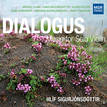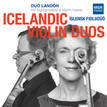HLíF SIGURJóNSDóTTIRAlso Available
 BELA BARTOK: 44 DUOSFor 2 ViolinsBéla Bartók HLíF SIGURJóNSDóTTIR Duo Landon: Hlíf Sigurjónsdóttir and Hjörleifur Valsson, Violins [MS1401] $12.95 LISTEN
REVIEWS
"The Icelandic artists in MSR's new recording certainly take convincingly to the Hungarian folk idioms that inform all forty-four of Bartók's unparalleled duos. No wonder. These sub Arctic MSR performers have impressive credentials and their extensive musical experiences at the boundary lands of Europe and Asia equip them expressly in Bartók's distinctive Hungarian / Magyar folk idioms.”Howard Smith, Music & Vision [June 2012]“Duo Landon approaches this music with down-to-earth vitality that underscores the sources of Bartók inspiration. Just as there is nothing academic about the composer’s work, there is nothing of the classroom in the performances, just fervor, elemental drive, plus sensitivity to the gentler pages in the collection… you’ll be amply rewarded by the artistry of composer and performers—as well as sonics that prove quite natural.”Lee Passarella, Audiophile Audition [October 2012]“I particularly like the way the Landon Duo plays the four different New Year’s Greetings. Scandinavian Violinists Hlif Sigurjónsdóttir and Hjörleifur Valsson play instruments constructed in 2003 and 2004 by Christophe Landon, so they call themselves the Landon Duo. Their violins are copies of instruments made by Antonio Stradivarius in 1714. The sound of these modern violins is excellent and not all that different from that produced by many of the old instruments with which we are familiar. Sigurjónsdóttir and Valsson are fine artists who play with great style and accuracy. Their attention to detail helps to unveil the composer’s limitless imagination and his ability to write in the historic styles of Central and Eastern European ethnic groups. The sound, recorded in 2005, is full and rich. The dynamic range is wide and makes this is a good disc for those with excellent sound systems who do not have to worry about close neighbors.… it is valuable to hear the pieces played in the order preferred for the concert stage by the composer. Sigurjónsdóttir and Valsson play them brilliantly.”Maria Nockin, Fanfare [September/October 2012]“Duo Landon performs Béla Bartók’s 44 Duos for 2 violins with great talent and clear interpretation... Despite the short length of each piece the musical themes are clearly attainable to the listener through Duo Landon’s precise articulations and attention to expressive detail. Between the two violinists there is an impressive balance between the performances of the basic and more difficult pieces leaving the listener with a sense of ease and satisfaction. Listeners looking for a variety of musical styles and techniques will thoroughly enjoy Duo Landon’s interpretation of Bartók’s 44 Duos.”WHQR 91.3 FM“The new CD of Béla Bartók’s 44 Duos is an exemplary one. Without exception the artists capture the composer’s limitless imagination in recreating Hungarian and other Central European historic styles. Perhaps most evident is the heartening way Bartók’s rhythmic vitality is made accessible to the listener, an accomplishment requiring precise articulation, the delineation of phrase structure, and a secure sense of the music’s interior metrical pulse… In addition, Bartók’s marvelous variety of styles is conveyed by the élan of the performers. Everything is here - dark, somber folk melodies, spritely dances, childlike moments (suiting the music´s underlying pedagogical intent), graceful imitative lines, and a strong sense of improvisation… The Duos are brief micro-moments but bare a musical soul that is rich, deep, and long-lived. This recording should be at the top of the list for 2006 and beyond."[Cecelia Porter, The Washington Post]“World class inspiration! {***** / 5-stars } This CD, featuring the 44 Duos for two violins by Béla Bartók in an outstanding interpretation by Duo Landon, will remain with this listener for many years to come, both as an inspiration and to accompany moments of solitude. Not only are the performances refined and musical in their fingertips, but also so genuinely felt that one assumes behind them is a lifetime of study and experience in the Balkan Countries.”Music Critic, Morgunblaðið Reykjavík - R.Ö. Pálsson [January 2006]PROGRAM NOTES
Violins by Christophe Landon, 2003 and 2004Copies of Antonio Stradivarius violins from 1714 Bows by Isaac Salchow and Gilles Nehr Béla Bartók was born in the Hungarian town Nagyszentmiklós (now Sannicolau Mare in Romania) in 1881. He showed notable musical talent at an early age, creating his first musical composition at the age of nine. Bartók studied at the Royal Academy of Music in Budapest in 1899-1903 where he met Zoltán Kodály, and they became lifelong friends and colleagues. In these years, he was influenced by composers such as Richard Strauss, whom he met in 1902, and Claude Debussy, whose compositions were introduced to him by Kodály. Bartók’s strong anti-fascist political views caused him great trouble in Hungary and he was forced to emigrate to the United States in 1940. He died in New York City in 1945. In 1908, Bartók and Kodály traveled around the Hungarian countryside in order to collect and research old Magyar folk melodies. They discovered that they were based on pentatonic scales similar to those in Asian folk traditions, but not, as commonly believed, on Gypsy music. In order to collect folk melodies, Bartók spent the next several years traveling through various countries, including Slovakia, Romania, Bulgaria, Moldavia, Walachia, Algeria and, in 1936, Turkey. The 44 Duos for Two Violins were composed in 1931 at the request of the German violinist and pedagogue Erich Doflein. The purpose was twofold: to provide young musicians with structured technical studies, and to introduce young players to folk music. The ethnic melodies upon which they are based originate in countries in the Slovak region, as well in the Arabic world. Two of the duos, Nos.36 and 36b, feature a melody composed by Bartók himself: Szól a duda (Bagpipes). Bartók fragments, develops and manipulates his chosen folk tunes in the Duos, placing them within the context of his own harmonic sense. They are rife with aurally challenging bi-tonal passages, poly-rhythms and plenty of brash dissonances. The 44 Duos are divided in four books, where the pieces advance in difficulty. The first and the second books suit typically a student at a basic level, the third for an intermediate player, and the fourth one for an advanced player. The 44 Duos are frequently performed in order, from 1 through 44, but on this disc we have chosen to follow Bartók’s own suggestions for performance order. Hlíf Sigurjónsdóttir was born in Denmark, of a Danish mother and Icelandic father, and grew up in Iceland. Upon graduation from the Reykjavík Music Conservatory, she furthered her violin studies at the Universities of Indiana and Toronto where her teachers were Franco Gulli and Lorand Fenyves, and at the Banff School of Fine Arts. Later she took private lessons in New York from the renowned violinist and teacher Gerald Beal. During the time of her studies, she was fortunate to work with many of the leading musicians of the twentieth century, including William Primrose, Janos Starker, Georges Janzer, György Sebok and the members of the Hungarian quartet; Zoltán Székely, Mihaly Kuttner, Denes Koromzay and Gabor Magyar. Sigurjónsdóttir has given numerous concerts as a soloist and with various ensembles and orchestras. She has premiered a number of works, some of which were dedicated to her. www.HlifSigurjons.is Icelandic violinist Hjörleifur Valsson began playing the violin at a local music school in Húsavík and later Ísafjörður where his teacher was Hlíf Sigurjónsdóttir. In 1988, he moved to Norway and became a pupil of Eivind Aadland and Grigorij Zhislin at the Oslo Music Academy. Upon graduation in 1993 he received a grant from the Czech government to study at the Conservatory in Prague for three years. During his stay there he made frequent appearances and recitals with the Greek-Cypriot pianist Ourania Menelaou, became acquainted with East-European folk music and played in a Moravian folk music ensemble. He later studied at the Folkwang Hochschule in Essen, Germany, and received his Music Degree there in the summer of 2000. While on the Continent, Valsson visited master classes of artists including Pierre Amoyal, Sergej Stadler, Truls Mörk and Pavel Gililov, and appeared in numerous concerts and recitals throughout Europe. Valsson is a versatile violinist with a highly personal and unique style. He has composed, performed and arranged music for theater, recorded for radio, television, movies and CD releases, and has collaborated with some of world’s leading musical personalities. [ www.HValsson.is ] Born in Fontainebleau, France in 1959, Christophe Landon made his first violin at the age of 15. Today he is a prize-winning violin maker and restorer, and an international dealer in instruments and bows. With headquarters located on Manhattan’s Upper West Side, he also maintains workshops in Paris, Berlin, Shanghai and Seoul. Landon is equally skilled in violin and bow making, two exacting and different skills. At an early age, Landon, who spent summers at the Mirecourt School in France, embarked on a non-stop learning course. He has apprenticed, interned and tutored in some of the most revered workshops and ateliers in the world, including that of Jean-Jacques Pages in Mirecourt, Max Möller in Amsterdam and Stephane Tomachot in Paris. Moving to New York in 1984, he worked with experts Jacques Français and Rene Morel. He won the Gold Medal Kassel for the sound of his asymmetrical viola in 1983 and first prize in the Maurice Vieux competition in 1986. In that same year, Landon founded Christophe Landon Rare Violins in New York, and began producing his own violins and bows as well as buying and selling fine Italian instruments and rare old French bows. Among his clients have been members of the New York Philharmonic, Berlin Philharmonic and Royal Concertgebouw Orchestra. His New York studio has become a popular destination for students from nearby academies, concert violinists and artists who favor both Landon’s own instruments and the world’s finest and rarest instruments and bows he offers. In 1996, Strings magazine featured Landon in a cover entitled: “Remarkable Instruments - Visionary Makers”. [ www.landon-violins.com ] PROGRAM
BÉLA BARTÓK (1881-1945)44 DUOS for Two Violins (Sz.98 / 1931) PERFORMANCE ORDER AS SUGGESTED BY BÉLA BARTÓK Transylvanian Dance (No.44) Fairy Tale (No.19) Burlesque (No.16) Sorrow (No.28) Pizzicato (No.43) Bagpipes (No.36) New Year’s Greeting 1 (No.21) Arabian Song (No.42) Matchmaking Song (No.1) Slovak Song (No.8) Pillow Dance (No.14) Hungarian Song 1 (No.6) Rhythm Song (No.20) Play Song (No.9) Bride’s Farewell (No.23) Comic Song (No.24) Scherzo (No.41) Walachian Song (No.7) Hungarian Song 2 (No.25) Harvest Song (No.33) Midsummer Night Song (No.4) Counting Song (No.34) Maypole Dance (No.2) Limping Dance (No.27) Lullaby (No.11) Mosquito Dance (No.22) New Year’s Greeting 3 (No.30) Wedding Song (No.13) New Year’s Greeting 4 (No.31) Dance from Máramaros (No.32) Soldier’s Song (No.15) Teasing Song (No.26) Menuetto (No.3) Slovakian Song 1 (No.5) New Year’s Greeting 2 (No.29) Hay Harvesting Song (No.12) Walachian Dance (No.40) Hungarian March 1 (No.17) Hungarian March 2 (No.18) Rumanian Whirling Dance (No.38) Prelude and Canon (No.37) Ruthenian Song (No.10) Ruthenian Kolomejka (No.35) Serbien Dance (No.39) Bagpipes (No.36b) Mosquito Dance - sul ponticello (No.22) MSR Classics |



